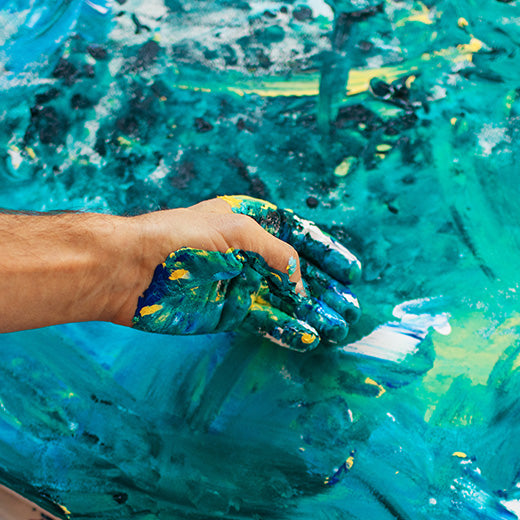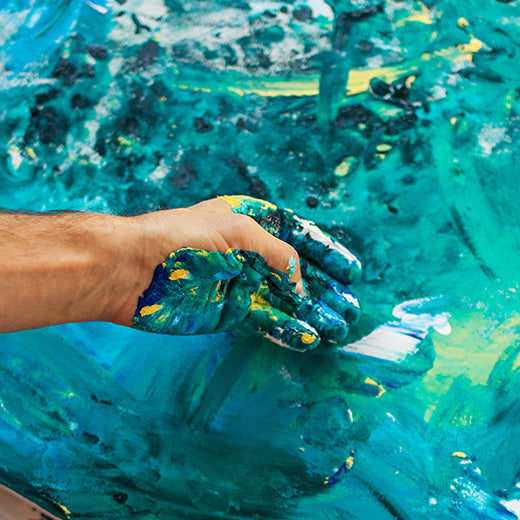Vancouver-based, Kathryn Wadel is an interdisciplinary mixed media artist, teaching practitioner and James Black Gallery associate.
As part of her pedagogical practice, Kathryn has been a coordinator and teaching artist at the Vancouver DeSerres Studio since 2016. Her practice explores the relationships between art, culture, science and social engagement.

Her work at the DeSerres Studio
Coalescing her passions for visual arts and community engagement, Kathryn creates an experiential learning environment where students gain knowledge, develop skills and connect with their creativity and community through art-making practices. Her classes draw influence from her artistic background, and she firmly believes in empowering people through art. She teaches beginner, intermediate and advanced level classes that explore theoretical, material and compositional development in painting, drawing, sculpture and mixed media.
Kathryn’s favourite products (and tips!)

1. Tri-Art Cell Flow Silicone Medium
This is one of her favourite products; she uses it to create cellular effects in acrylic pour paintings. This medium must be added to the paint prior to pouring onto the primed canvas or wood panel, otherwise the cellular effects will not appear. The differences in paint and oil densities will affect the size and types of cellular formations. Use an Artist’s Studio Torch or large palette knife to encourage the formation of more cells. She always recommends conducting colour and ratio experiments, and of course, documenting your findings in a sketchbook to use as future reference!

2. DeSerres Pouring Medium
Great for creating spectacular, fluid acrylic paintings, DeSerres Pouring Medium dries to a clear, non-yellowing and high-gloss finish with durable flexibility. This medium can be used with acrylic paints, inks, and in combination with the Tri-Art Cell Flow Medium. No brushes required!

3. DeSerres Mixed Media Pad
Created by Fabriano for DeSerres, this acid-free and eco-friendly paper is great for any mixed media artist. The paper’s heavy weight and textured quality means you can go back and forth between dry and wet mediums, without worrying that the paper will tear. If you want to experiment with a variety of different mediums, Kathryn recommends mixed media paper. It can be used with graphite, charcoal, chalk and oil pastels, watercolour, acrylic, ink, and more.

4. Blending Stumps
Consider blending stumps an extension of your fingers. They can be used to create seamless gradation in graphite or charcoal drawings. Human hands produce oils that can tarnish paper, so using blending stumps instead of your fingers can help prevent the tarnishing process. In addition, you won’t get as much graphite or charcoal on your fingertips, decreasing the likelihood of transferring undesired smudges across your drawing.

5. Yupo Paper
Kathryn fell in love with Yupo paper while studying at the Emily Carr University of Art + Design. Yupo paper is an archival polypropylene paper. Its non-porous surface is perfect for capturing gestural mark-making using acrylics, watercolours, alcohol inks, and more. In her professional art practice, Kathryn uses the 5 x 7-inch sizes for colour tests and compositional studies, and keeps them as reference in her sketchbook. At the DeSerres Studio, we use Yupo paper in our Introduction to Watercolour Painting and Ink on Yupo Paper classes.

6. Demco Gesso
Kathryn uses both black and white Demco Gessos in her painting practice. It can be used to prime surfaces for painting with acrylics and oils, and drawing with charcoal and pastels. For best results, apply gesso with a brush or roller in alternating horizontal and vertical layers, thinned with water to decrease chances of cracking. With each layer, reduce the ratio of water to gesso. You can even use sandpaper to ensure a completely smooth and textured finish. In addition to its priming purpose, you can use gesso as an underpainting to develop your artwork’s composition.






